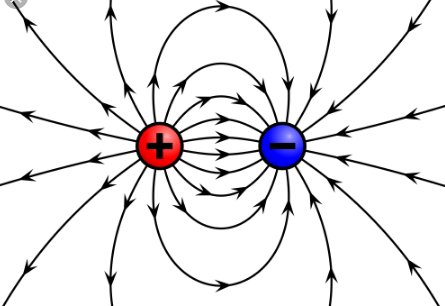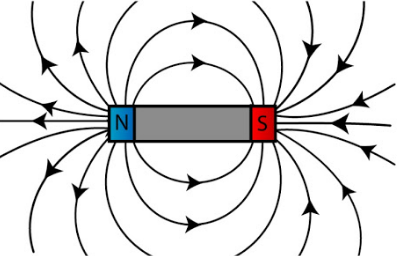What Is An Electric Field?

An electric field is a field of force surrounding a charged particle. If the magnitude of charge is large, then it may create a huge force around the region. The electric field is represented by imaginary lines of force. For the positive charge, the line of force come out of the charge and for negative charge the line of force will move towards the charge. The electric field is represented by the symbol E. the SI unit of the electric field is Newton per coulomb which is equal to volts per meter.
The electric field is mainly classified into two types that is:
- Uniform electric field. Uniform is when the electric field is constant at every point.
- Non-uniform electric field. Non-uniform is when the electric field is irregular at every point.
Properties Of Electric Field That You Need To Know
- An electric field is a field of force surrounding a charged particle.
- The strength of an electric field is expressed in Newtons per Coulombs (N/C) or Volts per meter (V/m).
- The force of an electric field is proportional to the electric charge.
- An electrometer is used to measure electric field intensity.
- The electric field is expressed by symbol E.
- The electric field lines are measured in two dimensions.
- The electric field is induced by a single charge (positive or negative charge).
- The electric field line can do work. When a particle enters an electric field, the electric field can influence the particle by changing its velocity as well as its direction.
- In the electric field, the like charges repel each other and unlike charges attract each other.
- The electric field line induces on a positive charge and extinguishes on a negative charge.
- The electric field is directly proportional to the flux.
- The electric field lines do not form a loop. The electric field is defined by straight field lines.
- The formula for electric field is Newton/Coulomb (N/C).
- Electric fields can be shielded easily by most materials such as trees and buildings.
- Electric field follows Gauss’s law (if there is symmetry).
- Electric charge can be isolated.
What Is Magnetic Field?
A magnetic field is a field of force surrounding a permanent magnet or a moving charged particle. A magnetic field, can also be described as, the invisible area around a magnetic object that can pull another magnetic object toward it or push another magnetic object away from it. These magnetic fields cannot be seen. They fill the space around the magnet where the magnetic forces work, and where they can attract or repel magnetic materials. Although we cannot see magnetic fields, we can detect them using iron filings (The tiny pieces of iron line up in a magnetic field).

The magnetic field is often visualized in terms of magnetic field lines, or lines of force, that leave one end of the magnet, called the North Pole, arc through space, and re-enter the magnet at the other end, the South Pole. Magnetic fields are created by moving electric charge and its strength is measured by the direction it points. The effects of magnetic fields are commonly seen in permanent magnets, which pull on magnetic materials (such as iron) and attract or repel other magnets.
What You Need To Know About Magnetic Field
- A magnetic field is a field of force surrounding a permanent magnet or a moving charged particle.
- A magnetic field strength is expressed in Gauss or Telsa.
- Magnetic field is proportional to the electric charge as well as the speed of the moving charge.
- The magnetometer is used to measure the magnetic field intensity.
- Magnetic field is expressed by symbol B.
- The magnetic field lines are measured in three dimensions.
- The magnetic fields induced by a north and South Pole of the magnet.
- The magnetic field cannot do work. When any particle enters the area of influence of a magnet, the magnet field cannot affect the velocity or direction of this particle. Basically, the work done by a magnetic field on a particle is zero.
- In a magnetic field the like poles repel each other and the unlike poles attract each other.
- The magnetic field lines generate from a north pole and terminate to the south pole of the magnet.
- The magnetic field depends on the number of field lines produced by the magnet.
- Magnetic field lines form a closed loop starting from the north pole and terminating at the south pole outside the magnet.
- The formula for magnetic field is Tesla or wb/m2
- Magnetic fields generally cannot be shielded easily.
- Magnetic field follows Ampere’s law (if there is a symmetry).
- Magnetic poles cannot be isolated.
Also Read: Difference Between Conductor, Insulator And Semi-Conductor
Difference Between Magnetic And Electric Field In Tabular Form
| BASIS OF COMPARISON | ELECTRIC FIELD | MAGNETIC FIELD |
| Description | An electric field is a field of force surrounding a charged particle. | A magnetic field is a field of force surrounding a permanent magnet or a moving charged particle. |
| Units Of Measurement (Expression) | The strength of an electric field is expressed in Newtons per Coulombs (N/C) or Volts per meter (V/m). | A magnetic field strength is expressed in Gauss or Telsa. |
| Relation To Electric Field | The force of an electric field is proportional to the electric charge. | Magnetic field is proportional to the electric charge as well as the speed of the moving charge. |
| Instrument Of Measurement | An electrometer is used to measure electric field intensity. | The magnetometer is used to measure the magnetic field intensity. |
| Symbol Of Expression | The electric field is expressed by symbol E. | Magnetic field is expressed by symbol B. |
| Scope Of Measurement | The electric field lines are measured in two dimensions. | The magnetic field lines are measured in three dimensions. |
| Inducement | The electric field is induced by a single charge (positive or negative charge). | The magnetic fields induced by a north and South Pole of the magnet. |
| Work | The electric field line can do work. When a particle enters an electric field, the electric field can influence the particle by changing its velocity as well as its direction. | The magnetic field cannot do work. When any particle enters the area of influence of a magnet, the magnet field cannot affect the velocity or direction of this particle. Basically, the work done by a magnetic field on a particle is zero. |
| Attraction & Attraction | In the electric field, the like charges repel each other and unlike charges attract each other. | In a magnetic field the like poles repel each other and the unlike poles attract each other. |
| Generation And Termination | The electric field line induces on a positive charge and extinguishes on a negative charge. | The magnetic field lines generate from a north pole and terminate to the south pole of the magnet. |
| Dependency | The electric field is directly proportional to the flux. | The magnetic field depends on the number of field lines produced by the magnet. |
| Formation Of A Loop | The electric field lines do not form a loop. The electric field is defined by straight field lines. | Magnetic field lines form a closed loop starting from the north pole and terminating at the south pole outside the magnet. |
| Formula | The formula for electric field is Newton/Coulomb (N/C). | The formula for magnetic field is Tesla or wb/m2 |
| Shielding | Electric fields can be shielded easily by most materials such as trees and buildings. | Magnetic fields generally cannot be shielded easily. |
| Conformity | Electric field follows Gauss’s law (if there is symmetry). | Magnetic field follows Ampere’s law (if there is a symmetry). |
| Isolation | Electric charge can be isolated. | Magnetic poles cannot be isolated. |
Similarities Between Electric Field And Magnetic Field
- Electric and magnetic fields oscillate at right angles to one another.
- Both electric and magnetic fields are vectors. They have directions and magnitude.
- Both magnetic and electric fields are perpendicular to one another.
- Both magnetic and electric fields are dipoles.
Comments are closed.